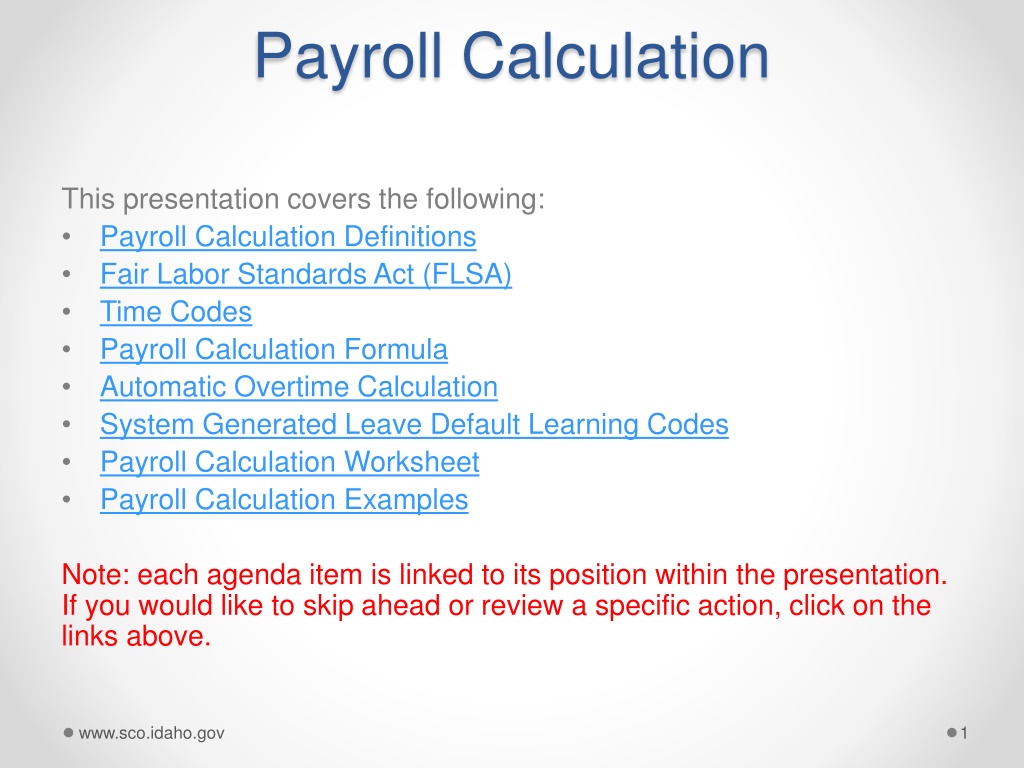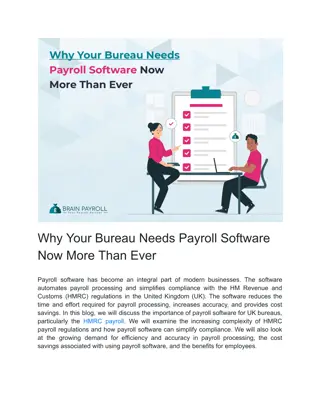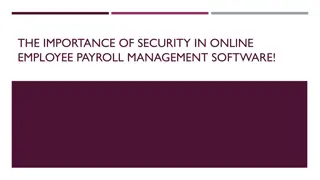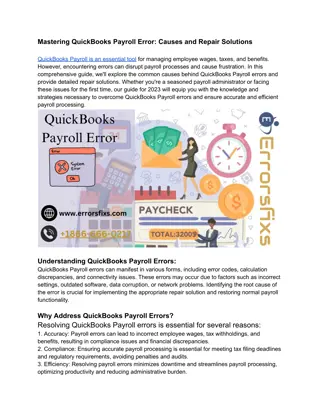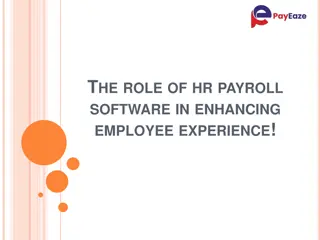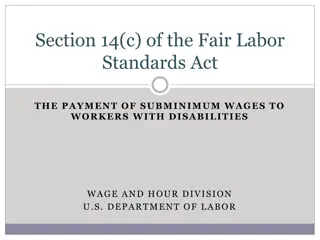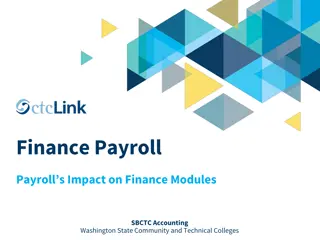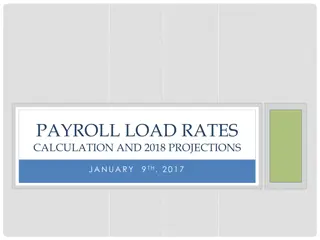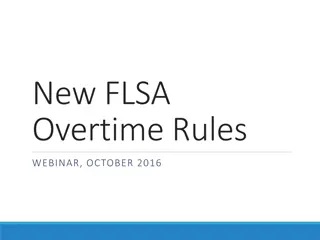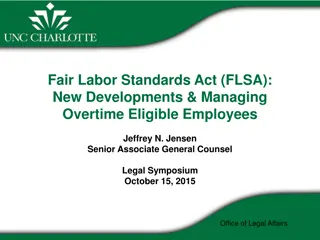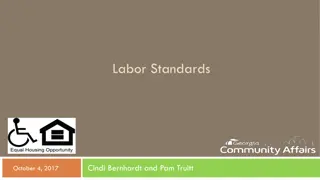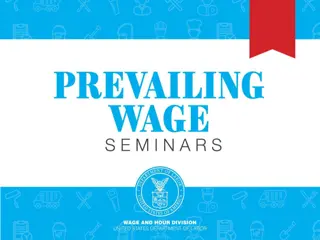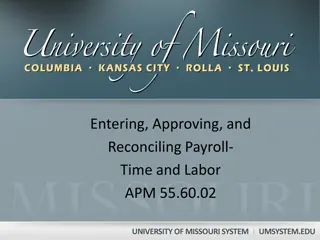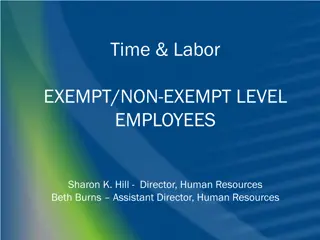Understanding Payroll Calculation and Fair Labor Standards Act (FLSA)
This presentation delves into the definitions of payroll calculation, focusing on hourly pay processes for state employees. It covers common codes, FLSA regulations, overtime compensation systems, leave accruals, and employee categorizations. Detailed explanations are provided for holiday pay, overtime hours, leave taken, and more. The significance of FLSA in establishing minimum wage, overtime pay, and labor standards for different employee types is highlighted.
Download Presentation

Please find below an Image/Link to download the presentation.
The content on the website is provided AS IS for your information and personal use only. It may not be sold, licensed, or shared on other websites without obtaining consent from the author. Download presentation by click this link. If you encounter any issues during the download, it is possible that the publisher has removed the file from their server.
E N D
Presentation Transcript
Payroll Calculation This presentation covers the following: Payroll Calculation Definitions Fair Labor Standards Act (FLSA) Time Codes Payroll Calculation Formula Automatic Overtime Calculation System Generated Leave Default Learning Codes Payroll Calculation Worksheet Payroll Calculation Examples Note: each agenda item is linked to its position within the presentation. If you would like to skip ahead or review a specific action, click on the links above. www.sco.idaho.gov 1
Payroll Calculation Definitions Since most state employees are paid hourly, that will be the focus of this presentation. Below are some common codes that are used during the hourly payroll calculation process: Holiday: a day of exemption from work where employees (those that are eligible for retirement benefits) are compensated as if they actually worked. Holiday Overtime: all hours worked on a holiday (applied to benefitted and non-benefitted employees) Overtime: actual time worked in excess of 40 hours with a work week (applies to benefitted and non-benefitted employees). Leave Taken: all paid and unpaid leave. Hours Worked: hours worked performing a job. www.sco.idaho.gov 2
Payroll Calculations: Fair Labor Standards Act The Fair Labor Standards Act (FLSA) establishes minimum wage, overtime pay, recordkeeping and child labor standards affecting full time and part time workers in the private sector and in federal, state and local governments. An employee s FLSA code determines how their pay and leave accruals are calculated. Under the FLSA, employees are categorized into one of four employee types: o Covered Employee o Exempt Employee o Executive Employee o Non-Covered Employee. www.sco.idaho.gov 3
Payroll Calculation: FLSA Covered Overtime is compensated at one and one-half (1 ) hours for each overtime hour worked. Employees that are covered under the FLSA regulations can accrue comp time or received payment. Comp time balances for covered employees shall be paid at the time of transfer to another state agency or upon separation from state service. The different types of covered employees are: C Covered Regular *(40 hr/ 7day period) F Covered Firefighters *(204 hr/ 27 day period) (Military Only) L Covered Law Enforcement Personnel *(160 hr/ 28 day period) Z Covered Seasonal and Emergency Response Personnel. * the number of hours before overtime is calculated/number of days in calculation period. www.sco.idaho.gov 4
Payroll Calculation: FLSA Exempt Overtime is earned and allowed on a one (1) hour for one (1) hour basis. Employees that are exempt under the FLSA regulations cannot be paid for their unused comp time but they are allowed comp time off from work. Comp time balances for exempt employees will be forfeited at the time of transfer to another state agency or upon separation from state service. The different type of exempt employees are: A Administrative Exempt (work related to management policies) I IT Computer Workers Exempt P Professional Exempt (teachers, attorneys, nurses) S Non-eligible, paid by the Board of Examiners (comp time payment with approval from the board of examiners). This code can only be used with the MC change reason. www.sco.idaho.gov 5
Payroll Calculation: FLSA Additional Exempt The following FLSA codes are used by employees who are exempt and are ineligible to accrue comp time under Idaho Code. FLSA codes B , J and Q have the same FLSA definitions as the current A administrative, I IT computer worker and P professional codes, but the employees cannot receive overtime pay or comp time. B Educational Administrative Exempt (work related to management policies) ineligible for overtime compensation. D Educational Executive Exempt ineligible for overtime compensation. E Executive Exempt (Department Chiefs) J Educational IT Computer Workers Exempt ineligible for overtime compensation. Q Educational Professional Exempt (teachers, attorneys, nurses) ineligible for overtime compensation. www.sco.idaho.gov 6
Payroll Calculation: FLSA Non-Covered Non-covered employees are ineligible for cash compensation or comp time for overtime work: N Non-Covered (elected officials, directors, etc.) Per Idaho Code, employees who become executive (FLSA D or E Executive or N Non-Covered) within their current agency shall have twelve (12) months from the date of the appointment to use any existing comp time balance. After twelve (12) months, any remaining comp time will be forfeited. www.sco.idaho.gov 7
Payroll Calculation: Time Codes Time codes consist of three characters and identify the type of earnings coded/processed for an employee. Some time codes are only used for specific agencies. Only time codes valid for the employee s FLSA/appointment type combination will be available for employee use. Under Time Code Maintenance , each agency s Central Payroll Officer (CPO) can designate which time codes are available to employees. Some time codes have been locked by the Division of Statewide Payroll (DPS) and can only be coded on an employee s time sheet by an I-Time CPO. Some time codes cannot be coded together (i.e. ACT and REG). For a complete list of time codes please see the DSP User Manual. www.sco.idaho.gov 8
Payroll Calculation Formula With automatic overtime calculation, the system automatically calculates overtime and earnings based on the employee s FLSA Code, overtime and shift indicators, in conjunction with the hours submitted on their time sheet. The Payroll Calculation Formula is works in the following order: 1. Holiday Pay 2. Holiday Overtime 3. Overtime over 40 hours 4. All Leave Taken 5. Regular time www.sco.idaho.gov 9
Payroll Calculation: Automatic Overtime Calculation Automatic overtime calculation in which the time entered on time sheets is automatically calculated by the payroll program. The system automatically calculated overtime (OTA, OTP, etc.) according to the employee s FLSA code, overtime indicator and their actual (ACT) hours submitted. Hours worked on a holiday must be coded with holiday overtime earnings codes (HA, HOS, HOW, HWL, HOP). The system will include these hours in the calculation of overtime for the week. Overtime will be automatically calculated when ACT is used. If REG is coded, overtime must be manually coding. The following payroll calculation examples show how the DSP system calculates automatic overtime calculation. www.sco.idaho.gov 10
Payroll Calculation: Generated Leave Default Codes If an employee codes more leave than is in their available balance, the system will use programed defaults to ensure the employee has exhausted all applicable leave balances before converting to leave without pay. For example: Standard Leave: SIC > GDC > GDH > GDV > GDL (Sick > Generated Default Comp > Generated Default Regular Hours Held Taken > Generated Default Vacation > Generated Default Leave Without Pay). In other words, if an employee codes more sick than he/she has, the system will look to see if the employee has comp time to use. If the employee has some comp time, it will be generated to bring the employee up to 40 hours. If the employee does not have any comp time, the system will continue to look for another leave code to bring the employee up to a full 40 hours. www.sco.idaho.gov 11
Payroll Calculation Worksheet SCO has a payroll calculation worksheet to use while calculating payroll. We will be using this worksheet in the following examples. www.sco.idaho.gov 12
Payroll Calculation Worksheet Holiday Pay: a day of exemption from work for which employees are paid as if they had worked (coded HOL). Holiday Overtime: is equal to all hours worked on a holiday. If a covered employee works on a holiday, you will times the hours worked by 1.5. If an exempt employee works on the holiday, you will times the hours worked by 1.0. Overtime: is equal to total hours worked (including hours worked on the holiday) minus 40. Regular: is equal to total hours worked (including hours worked on the holiday) minus all overtime (regular overtime and holiday overtime) www.sco.idaho.gov 13
Payroll Calculation Example www.sco.idaho.gov 14
Payroll Calculation Example www.sco.idaho.gov 15
Payroll Calculation Example Note: Since the employee coded HOA the time worked on the holiday is accrued to comp time. www.sco.idaho.gov 16
Payroll Calculation Example Note: Since the employee coded HOW instead of HOA, the time worked on the holiday was paid instead of accruing as comp time. www.sco.idaho.gov 17
Payroll Calculation: Example *Regular hours 30 = total hours worked (57) minus holiday over time (10.0) and regular overtime (17.0). *Need to add reg hours (30) and HOL (8). Total hours = 38.0 Since the rest of the time worked will only accrue to comp time, the system will use two hours of comp time to bring the employee up to 40 hours for the week (2.0 Generated Comp Time). www.sco.idaho.gov 18
Payroll Calculation Example www.sco.idaho.gov 19
Thank You for Participating! If you have additional questions that were not included in this online session, please utilize the following options: Access the help button in any SCO application Contact your local payroll office or E-mail the DSP Help Desk at dsphelp@sco.idaho.gov For questions regarding this PowerPoint or for training needs, please contact dsptrainer@sco.idaho.gov www.sco.idaho.gov 20
